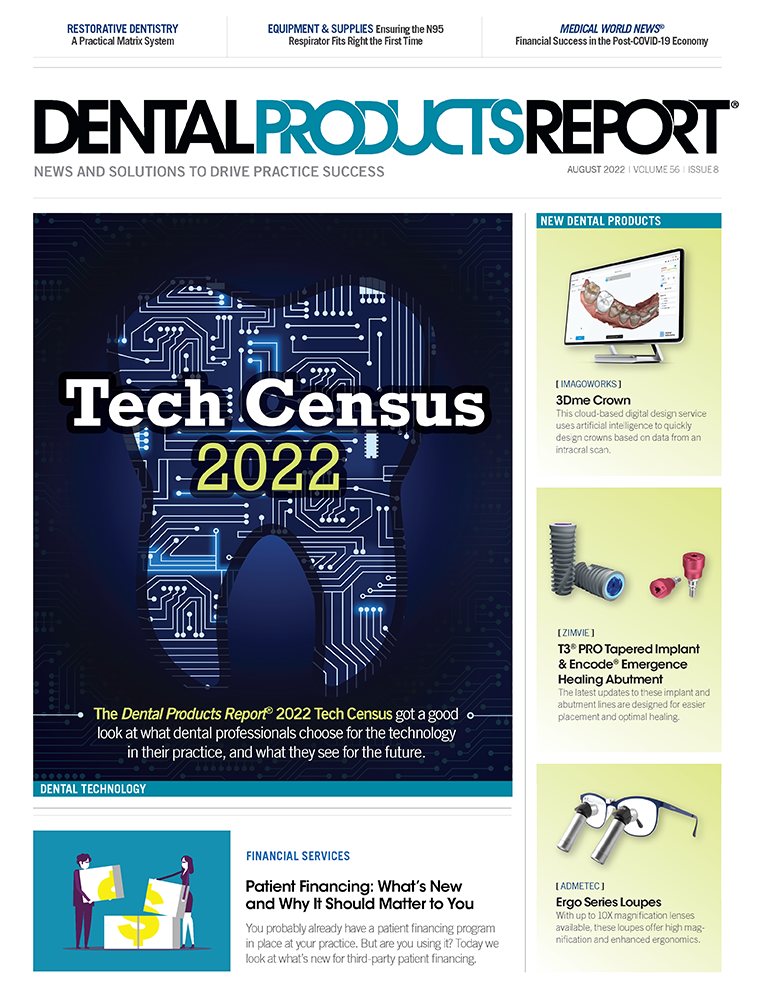Navigating Market Expansion in Dental Technology
Knowing what technologies are approved and suitable for dental patients is a matter of navigating the sometimes-tricky waters of the dental marketplace.
PINKEYES / STOCK.ADOBE.COM

We all have friends who, despite their age, never quite outgrow their insecurities. You know what I mean, the folks who think that if I’ve done something once, they’ve done it twice and better both times. As someone with a degree in psychology, these individuals fascinate me. Allow me to illustrate.
Bob and Jim have known each other for years, but their relationship is strained because anytime Bob tells a story, Jim immediately claims he has had a similar—but superior—experience. Bob tolerates Jim’s behavior but wishes it would stop.
As they walk along the street one afternoon, Bob hears the distinctive whine of a high-performance V-12 engine. He points to a car in the distance and exclaims, “Wow, look at that Lamborghini!” Jim replies, “Yes, I saw it about 10 seconds before you did.”
They walk a bit further, Bob points to a bird circling overhead and says, “Look at that bald eagle.” Jim answers, “Yes, I noticed it long before you did.” They walk a bit further and Bob says, “Hey, watch that…” But Jim cuts him off with “Yes, I saw it before you did.” To which Bob retorts: “Then why did you step in it?”
It’s a dumb joke, I admit. But it does show that simply claiming something is true doesn’t make it true. We live in a world in which discoveries are being continually made and where information is developed and distributed constantly. As I’ve said here before, our medical knowledge is doubling every 18 months, according to the statistics I’ve seen. That is a lot to keep up with.
Although that timeframe covers total health care information, dentistry, as we know, is changing almost exponentially. Trying not to fall behind is a bit like drinking from the proverbial fire hose. The rapid development of workflows that combine digital scanning, designing, and fabrication is steering the profession in ways we could only have dreamed of a decade ago.
The Curse of the “Me Too Company”
However, for every yin there is a yang and for every pro there is a con. Our knowledge is expanding more and more rapidly, but we must continuously keep aware of it, which is a daunting task, especially for a doctor whose main focus is the patient. Many of us spend countless hours outside of patient care trying to learn about the latest techniques and processes. Then along comes something like 3D printing, and suddenly we need to have a working knowledge of the hardware that creates the item, the software that designs it, and the companies that provide both. Oftentimes it seems as if we’re swimming upstream in a fast-flowing river of data.
Dentistry is a multibillion-dollar industry, and fortunes can be made quickly if you have the right ideas, the right marketing, and products that deliver what the advertising promises.
What follows is, admittedly, an oversimplification, but my goal is to broadly describe a scenario that can occur in any industry. It is not meant to be inclusive or an indictment of any company or process. I present it as food for thought for my peers in clinical practice, who may not ponder these questions as I do.
In any industry there is a fairly predictable product curve and invention and innovation come first in any business. A bright mind somewhere develops something that disrupts the status quo. In health care, a device or concept takes concrete shape: it becomes software or a prototype that is tested to make sure it works correctly. Then it goes to the United States Food and Drug Administration (FDA), which ensures that it is safe and efficacious. Afterward, and with great fanfare, the product is introduced to the market. The entire process requires a huge amount of money. Investors must be found, capital raised, and an organization built from the ground up.
If truly revolutionary, the product will send shockwaves through the industry. Doctors will learn of it, and other companies will begin to assess how the medical world will be affected by it. Almost at the same moment as the product hits the market, the process of reverse engineering begins.
Competition is good. I believe in it. Knowing that someone else is willing to take good care of a customer if I don’t is a good thing. It ensures that customers are always taken care of, and it keeps companies working hard to attract them. Monopolies are not only bad from price standpoint, they are incompatible with the idea of customer service. If there is only 1 source for a given good or service, where is the motivation to keep the customer happy or create new and/or better offerings?
However, reverse engineering sometimes creates the reverse problem. Let me explain. An amazing new device comes to market; it can do 5 new things and do them all well. The company that launched it is the first to market so it sets the price at $50,000. Let’s call this company “First.” The important thing about First is that it created the product from the ground up. The costs of development, manufacturing, testing, and FDA trials were all borne by First.
Reverse engineering allows a competitor to make a similar device. But this company is looking at a product that already exists. It takes it apart, sees how it works, closely examines the code that drives the software, and creates a rival product. We’ll call this company “Reverse.” The advantages of being Reverse is that it doesn’t have to spend money on R&D and it is subject to a less expensive approval process. First proved that the concept works; it blazed the trail. Reverse files for approval of something similar and gets it without spending nearly as much money, which means that it can charge less for it and get it to market quickly. In addition, Reverse’s product does fewer things. If the one from First does 5, perhaps the Reverse one does only 2—and can be sold for $40,000 instead of $50,000.
Reverse goes to market and uses what I like to call “me too” marketing. Anytime someone mentions or asks about First, its response is, “We can do that, and, by the way, we cost $10,000 less.”
Keeping Your Eye on the Ball
I mention this because we are about to witness a serious expansion in the dental market. Earlier this year, we saw the very first FDA approval of artificial intelligence (AI) technology as a chairside disease-detection aid.
You read that correctly. It is now possible to take a radiograph and have an AI platform analyze it for areas of potential pathology that you should look at more closely. It is a wholly objective system that is constantly learning and makes assessments of radiographs as they are taken.
This is a watershed moment for our profession. There have been a few similar moments, but not many with as big an impact as this one. Whether or not you realize it, AI is bringing a tidal wave of change to dentistry.
AI will not make a diagnosis or touch the patient. That is, and will remain, the doctor’s job. AI will simply provide more data for us to base our clinical decisions on. However, the data will grow exponentially.
That is why you need to know about the functions of, and the claims being made about, these systems. Competitors have begun to make “me too” claims and to say that they are FDA-approved. What the approval is for varies greatly from company to company. It will be incumbent upon practitioners to make sure they are using the systems for the right applications on the right patients.
For example, one company runs AI algorithms of bitewing and periapical radiographs, whereas others analyze only bitewings. The company that offers periapical AI also offers analysis of calculus, margin discrepancy, periapical radiolucency, bridges, crowns, fillings, implants, and root canals. Its competitors, however, apply AI only to caries on bitewings.
Nevertheless, all companies claim FDA approval. See the problem?
Preparing For the Future
I have been fortunate enough to have worked with some AI companies over the past few years, and I can say from personal experience that these systems work. They help you to find things and make better clinical decisions. They are poised to be serious disruptors in the dental space, and I welcome them. However, it is important that I tell you what to look for. You need to know what the system you purchase can and cannot do.
Like anything in our incredible profession, it is important to know and understand the proper usage of the tools we use to help our patients. By being fully aware of what the AI system you purchase can do, you will gain incredible clinical insights that will help you make better decisions.
Yet, it is just as important to know what it cannot do. Hopefully, companies will be honest about product limitations rather than hiding them in a fog of obfuscation.
Whatever happens, however, it will be the doctor’s responsibility to make the difficult decisions—about what system to buy and how to apply the knowledge it provides. No matter what a salesperson tells you, remember that you are the doctor and you are held to a very high standard, both legally and ethically.
Postscript
Some AI companies are also selling their services to insurers so that submitted images can be evaluated. I have a problem paying a company to help me provide better treatment if it then profits by assisting with the denial of that treatment. I refuse to spend my money on a company embracing that business model.

ACTIVA BioACTIVE Bulk Flow Marks Pulpdent’s First Major Product Release in 4 Years
December 12th 2024Next-generation bulk-fill dental restorative raises the standard of care for bulk-fill procedures by providing natural remineralization support, while also overcoming current bulk-fill limitations.
ACTIVA BioACTIVE Bulk Flow Marks Pulpdent’s First Major Product Release in 4 Years
December 12th 2024Next-generation bulk-fill dental restorative raises the standard of care for bulk-fill procedures by providing natural remineralization support, while also overcoming current bulk-fill limitations.
2 Commerce Drive
Cranbury, NJ 08512
All rights reserved.